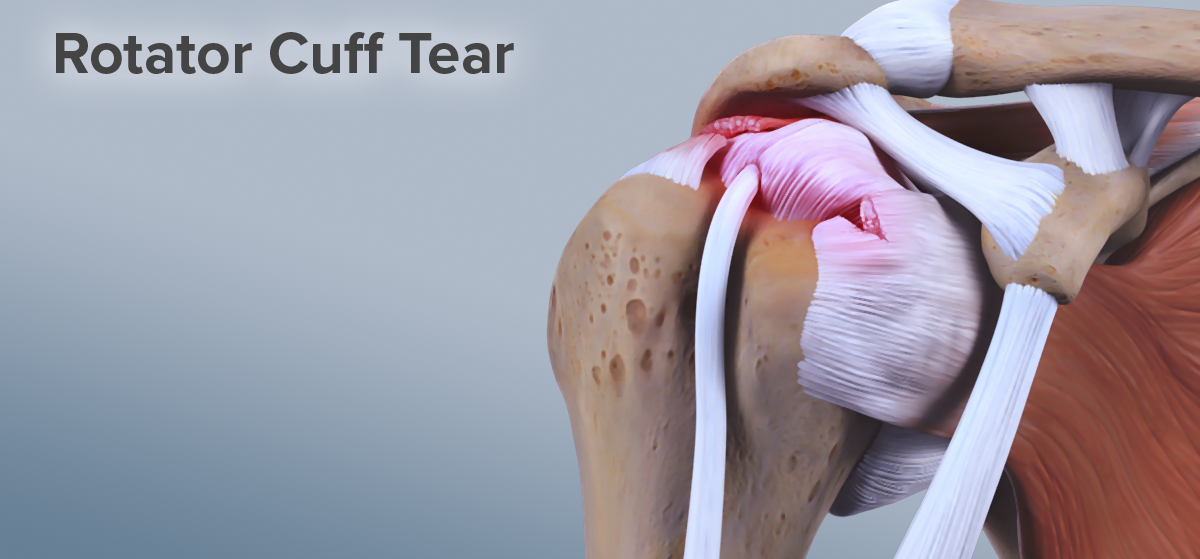
What is a rotator cuff tear?
A rotator cuff is a group of four muscles and tendons that help stabilize the shoulder. They also aid in movement. Every time you move your shoulder, you are using your rotator cuff to stabilize and help move the joint.
The rotator cuff is a commonly injured area. The most common injuries are strains, tendinitis, and bursitis.
What causes a rotator cuff injury?
Rotator cuff injuries can range from mild to severe. They tend to fall into one of three categories.
Tendinitis is an injury caused by overuse of the rotator cuff. This causes it to become inflamed. Tennis players, who use an overhead serve and painters who have to reach upward to do their jobs commonly experience this injury.
Bursitis is another common rotator cuff injury. It’s caused by inflammation of the bursa. These are fluid-filled sacs that sit between the rotator cuff tendons and the underlying bone.
Rotator cuff strains or tears are caused by overuse or acute injury. The tendons that connect muscles to bones can overstretch (strain) or tear, partially or completely. The rotator cuff can also strain or tear after a fall, a car accident, or another sudden injury. These injuries typically cause intense and immediate pain.
What are the symptoms of rotator cuff injury?
Not all rotator cuff injuries cause pain. Some are the result of degenerative conditions, meaning the rotator cuff could be damaged for months or years before symptoms start to appear.
Common rotator cuff injury symptoms include:
- avoiding certain activities because they cause pain
- difficulty achieving full range of shoulder motion
- difficulty sleeping on the affected shoulder
- pain or tenderness when reaching overhead
- pain in the shoulder, especially at night
- progressive weakness of the shoulder
- trouble reaching behind the back
If you’ve been experiencing any of these symptoms for longer than a week or lose function in your arm, see your doctor.
Who is at risk for rotator cuff injuries?
Rotator cuff injuries can be acute or degenerative.
Acute injuries usually occur from one particular incident. These can be caused by lifting objects that are too heavy, falling, or having the shoulder forced into an awkward position. Young people are more likely to experience this type of rotator cuff injury.
Degenerative injuries are due to long-term overuse. People most at risk for these injuries include:
- athletes, particularly tennis players, baseball players, rowers, and wrestlers
- people with jobs that require repetitive liftings, such as painters and carpenters
- people above 40 years of age
How is a rotator cuff injury diagnosed?
Doctors use medical history, a physical exam, and imaging scans to diagnose rotator cuff injuries. They may ask about physical activities at the workplace. These questions determine whether a patient has an increased risk for a degenerative condition.
Your doctor will also test the arm’s range of motion and strength. They will also rule out similar conditions, such as a pinched nerve or arthritis.
Imaging scans, such as an X-ray, can identify any bone spurs. These small bone growths can rub against the rotator cuff tendon and cause pain and inflammation.
Magnetic resonance imaging (MRI) or ultrasound scans can also be used. These tools examine soft tissues, including tendons and muscles. They can help identify tears, as well as show how large and severe the tears have become.
How is a rotator cuff injury treated?
Treatments range from resting the affected arm to surgery. Tendinitis can progress to a rotator cuff tear, and that injury can get worse with time. Seeking treatment as quickly as possible help keep the injury from progressing.
Nonsurgical treatments improve symptoms in about 50 percent of people with a rotator cuff injury. These kinds of treatments include:
- applying hot or cold packs to the affected shoulder to reduce swelling
- exercises to restore strength and range of motion
- injecting the affected area with cortisone, a steroid that helps to reduce inflammation
- resting the affected arm and wearing a sling to isolate arm motions
- over-the-counter anti-inflammatory medications, such as ibuprofen and naproxen
Research indicates that the timing of surgery doesn’t affect outcomes. This means if you have a rotator cuff injury, your doctor is likely to first try nonsurgical methods.
What is the outlook for a rotator cuff injury?
The prognosis for a rotator cuff injury depends upon the injury type. Half of those with a rotator cuff injury recover using exercise and at-home care. These interventions reduce pain and encourage a range of motion.
In the case of a more severe rotator cuff tear, shoulder strength may not improve unless the injury is surgically corrected.
How can a rotator cuff injury be prevented?
Athletes and people with occupations that require using the shoulder should take frequent rest breaks. This can reduce the load on the shoulder. Exercises to strengthen the shoulder and encourage a range of motion also can help. Ask your physical therapist for stretches and strengthening exercises to improve the function of your rotator cuff.
In the case of shoulder pain, icing the affected area can help reduce swelling. Apply ice in a cloth-covered pack for no more than 10 minutes at a time. These activities can also help prevent re-injury.
Precision Pain Care and Rehabilitation has two convenient locations in Richmond Hill – Queens and New Hyde Park – Long Island. Call the Richmond Hill office at (718) 215-1888, or (516) 419-4480 for Long Island office, to arrange an appointment with our Interventional Pain Management Specialist, Dr. Jeffrey Chacko.













